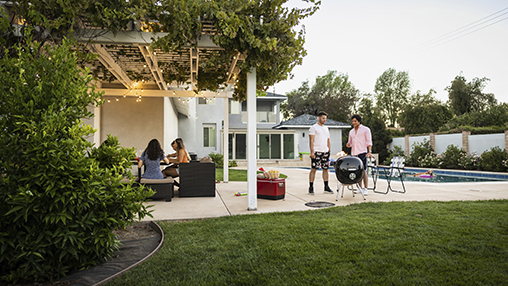
Conventional Refinance
Calculate Your
Monthly Payment
Calculate Your Monthly Payment

A Conventional Loan Could Make Home Refinancing Easy For You.
- Find which loan works for you, a lower monthly payment or a shorter term**
- Equity 20% or higher means no mortgage insurance
- Available for primary residences, second homes or investment properties
- Choose a fixed-rate or adjustable-rate mortgage (ARM)
** By refinancing your existing loan, your total finance charges may be higher over the life of the loan.
Today's Conventional Refinance Rates
See at a glance how VA IRRRL rates stack up today. Compare different mortgage loan types and learn more about how VA IRRRL can make your monthly mortgage payments more stable and affordable.
*
Discount points apply, view assumptions for details. Rates valid on:
Wed, Jul 12 2017, 09:49 AM PT and are subject to change without notice.
*
Discount points apply, view assumptions for details. Rates valid on:
Wed, Jul 12 2017, 09:49 AM PT and are subject to change without notice.
Rates display is temporarily unavailable.
For a rate quote, please call a Pennymac Loan Officer at (866) 549-3583.
What is a Conventional Refinance?
When preparing to refinance your home, it’s important to take the time to search for the best new mortgage possible — a loan with the rates, term, and other options that align with your financial situation.
A conventional refinance is the process of obtaining a new conventional mortgage in order to pay off and eliminate the previous loan that you had on your home. For those who meet the criteria, a conventional loan can be used to replace any other type of existing mortgage.
Resources & Tools
Get a Customized Rate Quote
Tell us what you’d like to do, and we’ll give you a quick estimated quote of your potential monthly payment options based on the information you enter. You can also talk to a Pennymac Loan Expert for a one-on-one review, or get your application started at My Home By Pennymac.
Refinance Loan Calculators
Use today's rates to get a better understanding of the true cost of different mortgage products before chatting with one of our licensed loan officers.
Mortgage Learning Center
We’re always adding new articles and resources to our Learning Center to help provide you with unbiased, useful mortgage information on a wide range of topics.
Home Value Estimator
Get a report on the estimated value of your home that provides two estimated market values from leading providers.
The Benefits of a Conventional Refinance Include:
Reduce or remove FHA or USDA mortgage insurance.
For FHA and USDA loans, mortgage insurance is paid throughout the life of the loan, where with a conventional home loan it’s only temporary. Whether you have FHA or USDA mortgage insurance, or private mortgage insurance (PMI), completing a conventional refinance once you have at least 20% equity (or 80% loan-to-value) in your home will eliminate this extra monthly cost.
Avoid mortgage insurance with 80% loan-to-value (LTV).
Loan-to-value is the amount you owe on your mortgage in comparison to the value of your home. For example, if your home is worth $250,000, and you owe $125,000 on your mortgage, you have a LTV of 50%. For that same $250,000 home, if you owe $200,000 (80% of your home value), you will have 20% in equity. In both cases, you wouldn’t need mortgage insurance because your LTV would be 80% or less.
Refinance out of virtually any type of loan.
Whether you want to switch from an adjustable-rate mortgage (ARM) to a fixed-rate, change the loan term of an existing fixed-rate mortgage, or convert from an FHA, a conventional refinance can help you meet your financial goals.
Can be used to reimburse yourself for a home paid for in cash.
If you have a large amount of equity in your home, or even a home that is paid off, you can take out a conventional mortgage on that home, then use the proceeds to fund other investments and projects.
Conventional Refinance Loan Types
Conventional refinance loans come in two major types: fixed-rate and adjustable-rate mortgages, commonly referred to as ARMs. Those two types each come with several options.
These long-term loans allow you to pay back your mortgage over the term with a fixed interest rate, and offer the lowest fixed interest rates for eligible buyers.
A 30-year mortgage is the longest term offered. 15-year and 20-year fixed-rate mortgages are very similar to 30-year mortgages, but with the shorter term. They may therefore have slightly higher monthly payments and generally less interest paid over time.
- Plan to stay in your home for a longer period of time
- Have good credit
- Want to lower your monthly payment
- Need to consolidate debt
- Are looking to take cash out
These offer the lowest rate for the first 3-10 years of the loan for eligible buyers. After the initial term, your rate will adjust based on current rates and may increase or decrease, depending on the market.
- Think you’ll be moving before being exposed to the risk of higher rates
- Want a low rate, fixed rate for the first few years
- Think rates will decrease after your fixed period
- Have good credit
For many homeowners, their largest investment is their house. If you want to put that investment to work in other ways, one option is a cash-out refinance. If you have a home that is worth $250,000 with a mortgage balance of $150,000, you may be able to refinance to a new loan with a balance of $200,000. This new loan will come with a “cash-out” surplus of $50,000 that you can use for other financial needs.
- Plan to remodel
- Need to cover medical expenses
- Have to fund a college tuition
- Want to pay for a wedding
Am I Eligible for an FHA Mortgage?
With today’s low rates and high home values, refinancing makes valuable financial sense for many homebuyers to lower a monthly payment, take cash out or even consolidate debt. To get the help you need through the entire refinance process, contact a Pennymac Loan Officer today or apply online to get started.
Sorry the service is unavailable currently. Please visit Birdeye.com website to view Pennymac, LLC. reviews
Frequently Asked Conventional Mortgage Questions
How Does a Conventional Refinance Benefit Me?
Depending on your unique financial situation, a conventional refinance can benefit you in many ways, including lowering your monthly payment, eliminating unnecessary costs like mortgage insurance, providing a loan at a lower interest rate, cashing out equity for other projects, or changing your loan term to a timeline that aligns with your goals.
How Much Equity Do I Need to Refinance to a Conventional Loan?
A conventional loan refinance can be obtained with as little as 5% equity, but will require mortgage insurance if you have less than 20% equity, or 80% loan-to-value (LTV).
How Soon Can I Refinance to a Conventional Loan?
Generally there’s no waiting period required between loans. However, you should discuss factors like closing costs, interest rate changes, and any changes in your financial situation with your lender when considering a refinance.
Can I Use a Conventional Refinance to Consolidate Debt?
A conventional refinance can be used to consolidate debt by doing a cash-out refinance. With a loan of this type, you can take equity from your home to pay off other debts. A conventional refinance can come with a fixed, low interest rate that is often preferable to other forms of debt with higher and/ or variable rates.
How Can a Conventional Refinance Lower My Payment?
If you refinance your mortgage to a new conventional loan with a longer term, a lower rate, or both, your monthly payment will most likely be lower. In addition, if you are able to eliminate mortgage insurance through a refinance, you will no longer have to pay for that monthly expense.
Is a Conventional Refinance Different From an FHA Streamline?
FHA Streamline refinances are only available to homebuyers with a current FHA loan, whereas conventional refinances are available to homeowners with any existing loan type. FHA streamline refinance loans don’t have all of the same income verification and appraisal requirements that conventional refinances do, but they do come with other specific rules and restrictions that conventional refinances do not.
Can I Get a Conventional Refinance on an Investment or Second Home?
Most likely, yes. Unlike an FHA loan or refinance, conventional home loan refinances can be obtained for second or vacation homes, investment properties, and other asset types aside from your primary residence.
How Is an ARM Different Than a Fixed-Rate Refinance?
An adjustable-rate mortgage, or ARM, has an initial loan term with low principle and interest payments with a fixed rate, and then a second term during which the interest rate becomes variable. During the variable period, the ARM rate will adjust at scheduled intervals to a new rate that is based on larger financial indexes.
How Do I Apply For a Conventional Refinance?
To apply for a conventional mortgage, you will select a lender, complete a mortgage application, and then provide your lender with any documents or other items needed in order to establish your background, credit score, and financial history. After the application stage, your conventional refinance loan will go through the underwriting stage, and then, finally, closing.


















